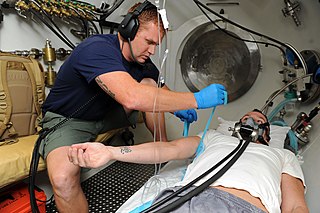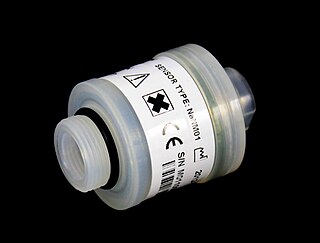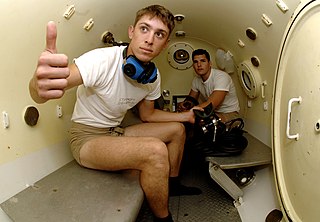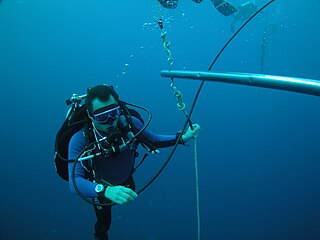The topic of this article may not meet Wikipedia's notability guideline for academics .(December 2013) |
Richard Deimel Vann is an American academic and diver.
The topic of this article may not meet Wikipedia's notability guideline for academics .(December 2013) |
Richard Deimel Vann is an American academic and diver.
Vann is a consultant was a Divers Alert Network, [1] Assistant Professor Emeritus in Anesthesiology at Duke University Medical Center,[ citation needed ] and safety officer and director of applied research at Duke University Medical Center, [2]
{{cite journal}}: Cite journal requires |journal= (help){{cite journal}}: CS1 maint: multiple names: authors list (link) CS1 maint: unfit URL (link){{cite journal}}: CS1 maint: multiple names: authors list (link) CS1 maint: unfit URL (link){{cite journal}}: CS1 maint: multiple names: authors list (link){{cite journal}}: CS1 maint: multiple names: authors list (link){{cite journal}}: CS1 maint: unfit URL (link){{cite journal}}: CS1 maint: multiple names: authors list (link)
Decompression sickness is a medical condition caused by dissolved gases emerging from solution as bubbles inside the body tissues during decompression. DCS most commonly occurs during or soon after a decompression ascent from underwater diving, but can also result from other causes of depressurisation, such as emerging from a caisson, decompression from saturation, flying in an unpressurised aircraft at high altitude, and extravehicular activity from spacecraft. DCS and arterial gas embolism are collectively referred to as decompression illness.

Oxygen toxicity is a condition resulting from the harmful effects of breathing molecular oxygen at increased partial pressures. Severe cases can result in cell damage and death, with effects most often seen in the central nervous system, lungs, and eyes. Historically, the central nervous system condition was called the Paul Bert effect, and the pulmonary condition the Lorrain Smith effect, after the researchers who pioneered the discoveries and descriptions in the late 19th century. Oxygen toxicity is a concern for underwater divers, those on high concentrations of supplemental oxygen, and those undergoing hyperbaric oxygen therapy.

Michael Landon Gernhardt is a NASA astronaut and manager of the Environmental Physiology Laboratory, and principal investigator of the Prebreathe Reduction Program (PRP) at the Lyndon B. Johnson Space Center.

An electro-galvanic fuel cell is an electrochemical device which consumes a fuel to produce an electrical output by a chemical reaction. One form of electro-galvanic fuel cell based on the oxidation of lead is commonly used to measure the concentration of oxygen gas in underwater diving and medical breathing gases.

Diving medicine, also called undersea and hyperbaric medicine (UHB), is the diagnosis, treatment and prevention of conditions caused by humans entering the undersea environment. It includes the effects on the body of pressure on gases, the diagnosis and treatment of conditions caused by marine hazards and how relationships of a diver's fitness to dive affect a diver's safety. Diving medical practitioners are also expected to be competent in the examination of divers and potential divers to determine fitness to dive.

Christian James Lambertsen was an American environmental medicine and diving medicine specialist who was principally responsible for developing the United States Navy frogmen's rebreathers in the early 1940s for underwater warfare. Lambertsen designed a series of rebreathers in 1940 and in 1944 and first called his invention breathing apparatus. Later, after the war, he called it Laru and finally, in 1952, he changed his invention's name again to SCUBA. Although diving regulator technology was invented by Émile Gagnan and Jacques-Yves Cousteau in 1943 and was unrelated to rebreathers, the current use of the word SCUBA is largely attributed to the Gagnan-Cousteau invention. The US Navy considers Lambertsen to be "the father of the Frogmen".
The Undersea and Hyperbaric Medical Society (UHMS) is an organization based in the US which supports research on matters of hyperbaric medicine and physiology, and provides a certificate of added qualification for physicians with an unrestricted license to practice medicine and for limited licensed practitioners, at the completion of the Program for Advanced Training in Hyperbaric Medicine. They support an extensive library and are a primary source of information for diving and hyperbaric medicine physiology worldwide.

Capt. Edward Deforest Thalmann, USN (ret.) was an American hyperbaric medicine specialist who was principally responsible for developing the current United States Navy dive tables for mixed-gas diving, which are based on his eponymous Thalmann Algorithm (VVAL18). At the time of his death, Thalmann was serving as assistant medical director of the Divers Alert Network (DAN) and an assistant clinical professor in anesthesiology at Duke University's Center for Hyperbaric Medicine and Environmental Physiology.
Professor Albert Alois Bühlmann was a Swiss physician who was principally responsible for a number of important contributions to decompression science at the Laboratory of Hyperbaric Physiology at the University Hospital in Zürich, Switzerland. His impact on diving ranged from complex commercial and military diving to the occasional recreational diver. He is held in high regard for his professional ethics and attention to his research subjects.

Simon Mitchell is a New Zealand physician specialising in occupational medicine, hyperbaric medicine and anesthesiology. Trained in medicine, Mitchell was awarded a PhD for his work on neuroprotection from embolic brain injury. Mitchell has also published more than 45 research and review papers in the medical literature. Mitchell is an author and avid technical diver. He also wrote two chapters of the latest edition of Bennett and Elliott's Physiology and Medicine of Diving, is the co-author of the diving textbook Deeper Into Diving with John Lippmann and co-authored the chapter on Diving and Hyperbaric Medicine in Harrison's Principles of Internal Medicine with Michael Bennett.

Decompression theory is the study and modelling of the transfer of the inert gas component of breathing gases from the gas in the lungs to the tissues and back during exposure to variations in ambient pressure. In the case of underwater diving and compressed air work, this mostly involves ambient pressures greater than the local surface pressure, but astronauts, high altitude mountaineers, and travellers in aircraft which are not pressurised to sea level pressure, are generally exposed to ambient pressures less than standard sea level atmospheric pressure. In all cases, the symptoms caused by decompression occur during or within a relatively short period of hours, or occasionally days, after a significant pressure reduction.

Robert William Hamilton Jr., known as Bill, was an American physiologist known for his work in hyperbaric physiology.
Shearwater Research is a Canadian manufacturer of dive computers and rebreather electronics for technical diving.

Eugene Weston Hobbs II, known as Gene Hobbs is an American technical diver and founding board member of the non-profit Rubicon Foundation. Hobbs has served as medical officer for the Woodville Karst Plain Project since 2004 and was named the 2010 Divers Alert Network/ Rolex Diver of the year. Hobbs was a hyperbaric technologist and simulation coordinator at Duke Medical Center before taking a position as the Director of Simulation for the University of North Carolina School of Medicine and Clinical Instructor in the Department of Pediatrics. As of 2018, Hobbs is the business manager for the UNC Health Care Department of Neurosurgery.

Neal Pollock is a Canadian academic and diver. Born in Edmonton, Canada he completed a bachelor's degree in zoology; the first three years at University of Alberta and the final year at the University of British Columbia. After completing a master's degree he then served as diving officer at University of British Columbia for almost five years. He then moved to Florida and completed a doctorate in exercise physiology/environmental physiology at Florida State University.

The physiology of decompression is the aspect of physiology which is affected by exposure to large changes in ambient pressure, and involves a complex interaction of gas solubility, partial pressures and concentration gradients, diffusion, bulk transport and bubble mechanics in living tissues. Gas is breathed at ambient pressure, and some of this gas dissolves into the blood and other fluids. Inert gas continues to be taken up until the gas dissolved in the tissues is in a state of equilibrium with the gas in the lungs,, or the ambient pressure is reduced until the inert gases dissolved in the tissues are at a higher concentration than the equilibrium state, and start diffusing out again.
Investigation of diving accidents includes investigations into the causes of reportable incidents in professional diving and recreational diving accidents, usually when there is a fatality or litigation for gross negligence.
{{cite journal}}: Cite journal requires |journal= (help){{cite journal}}: Cite journal requires |journal= (help)